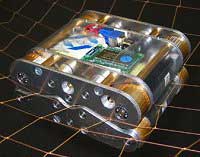Robotic “spiders” could help build large-scale structures in space. They would inch their way across large nets of fabric in space performing small tasks or lining up to create an antenna or some other structure.

The concept, known as a Furoshiki satellite, could revolutionise satellite-based applications by providing cost effective large antennas in space that can be launched on small rockets.
The Japanese Aerospace Exploration Agency is planning to test a Furoshiki spacecraft in January 2006. Once in space, the mother satellite will deploy three ‘daughters’. These will pull out a net into a triangle, leaving the mother satellite at the centre. Two palm-sized robots will then ‘crawl’ along the net into prearranged positions.
This is the first small step towards satellites that collect solar energy using large arrays of solar panels and then beam the energy down to Earth. Such satellites could revolutionise the Earth’s energy supply systems by providing large amounts of clean solar energy. “A solar power satellite would need very large structures for its solar panels and antenna. Small experiments like this can help us mature the technology needed to build them,” says Leopold Summerer from ESA’s Advanced Concepts Team.
Via ESA.
